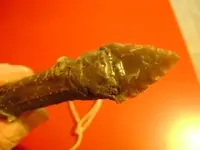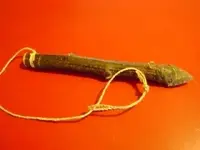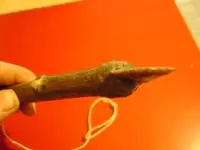TripleCreek
Jr. Member
- Joined
- Jan 27, 2009
- Messages
- 71
- Reaction score
- 2
- Golden Thread
- 0
- Location
- Mid Maryland
- Detector(s) used
- Tesoro- DeLeon
I have always believed that the small lecroy points, that are found at early to mid archaic sites, were actually small knifes used to strip bark from smooth barked trees, like hickory and elm. I have produced this replication using only stone & bone tools. The handle is a made from the branch of a chestnut tree, and assembled completely green. The cuts for the handle were made with a bone saw, from the shell of a snapping turtle. The hafting notch was sawn about one quarter inch deep and one 1/4 inch wide. In the bottom of the notch, I used a stone drill, mounted on a wood shaft, and hand spun, to drill two holes that match the two prongs on the bottom of the lecroy point. This let the wider part of the bottom of the point to "bottom out" in the notch. After the point was inserted and sealed with a pine pitch adhesive, the handle was reinforced at the half with sinew. Pine pitch adhesive is made from White pine sap heated, until most of the water is evaporated. A small amount of hardwood "ash" is added to stabilize the sap, and and keep it from "crystallizing" This mixture acts just like "hot glue", it is liquid when hot, but cools to a strong adhesive. No "dry time" is needed with this glue. Everything (the wood handle, and stone point) is pre heated, when using this adhesive mixture, to make sure the bond preform well; otherwise the pitch will cool to quickly when touching the stone or wood, and be a weak bond. The Lancelot around the handle is "hand made" cordage, made from the fibers of the "dogbane" plant, a form of milkweed.
Thanks for looking,
3creeks
Thanks for looking,
3creeks
Attachments
Upvote
0





